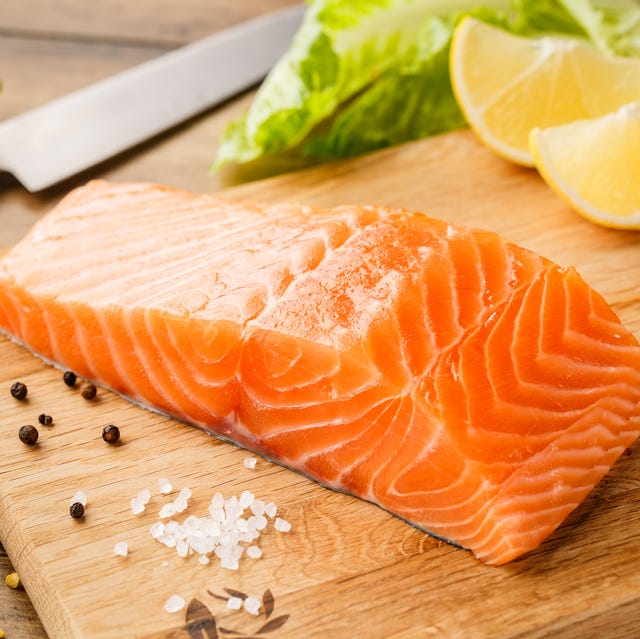We earn a commission for products purchased through some links in this article.

Salmon

Not only is salmon a great option if you’re looking to up your protein, but it’s also rich in vitamin D. A 140g serving of baked salmon packs about 10.2 µg of vitamin D, according to the British Nutrition Foundation, while the same amount of pink canned salmon contains 15.3 µg. Wild-caught salmon also contains almost four times the amount of vitamin D than farm-raised salmon, adds Moskovitz.
Mushrooms

If you’re looking for a plant-based vitamin D source, go with mushrooms. 80g of Vitamin D-enriched mushrooms contains 3.2 µg.
‘Prioritize fresh, wild mushrooms, such as chanterelles and morels, over store-bought mushrooms because mushrooms that are exposed to sunlight provide more vitamin D,’ says Moskovitz.
Another option is to place store-bought mushrooms in the midday sun for about 15 to 20 minutes and you can naturally increase the vitamin D they provide, she adds.
Advertisement – Continue Reading Below
Fortified Milk

In addition to being a stellar source of calcium, one cup of fortified cow’s milk comes with 115 IU of vitamin D, while fortified soy milk contains around 100 to 119 IU (around 16 to 19 per cent of what women need daily). Fortified milk is also packed with protein, potassium, vitamin B12, and calcium, according to Harvard School of Public Health.
Eggs

Whether you like ’em scrambled or sunny side up, each egg yolk contains vitamin D – although how you cook it depends on how much you’ll get. 1 boiled egg (50g) gives 1.6 µg, while 2 scrambled eggs (120g) offers 3.4 µg of vitamin D.
If it’s accessible to you, free-range eggs also contain up to three to six times more vitamin D than regular eggs, says Moskovitz.
Just remember that the vitamin D is inside the yolk, so eat the *entire* egg and not just the egg whites!
Advertisement – Continue Reading Below
Fortified Orange Juice

If you prefer to drink your vitamin D, fortified orange juice is a great option since one cup has up to 100 IU (2.5 µg) of vitamin D, which is about 16 per cent of a woman’s daily need. Just make sure you check the label and purchase fortified orange juice because regular juice lacks the extra nutrients. Also, be mindful about how much juice you consume per day because it can be high in sugar.
Sardines

You can love ’em or hate ’em, but sardines are one of the most nutrient-dense seafoods with 140g of canned sardines offering 4.6 µg of vitamin D.
Plus, sardines are one of the cleanest and healthiest seafood sources, according to the Cleveland Clinic, since they’re also packed with omega-3 fatty acids and protein and don’t contain heavy metals or toxins.
Advertisement – Continue Reading Below
Rainbow Trout

Another excellent source of vitamin D from the ocean? Rainbow trout. With 600 to 700 IU (15 µg) of vitamin D per 85g serving, this tasty fish covers your entire day’s vitamin D requirement, says Moskovitz. Try cooking it on the grill or tossing it in the air fryer for some extra crispiness.
Fortified Cereal

Cereals are another food commonly fortified with vitamin D, with around 1.4 µg of vitamin D per 30g serving.
‘Not all cereals are created equal, though, so some cereals may have more or less vitamin D,’ notes Moskovitz. If the label doesn’t say fortified, it won’t be a source of vitamin D. Always keep an eye out for that word and figure out how much of the nutrient is in the product, she adds.
Advertisement – Continue Reading Below
Canned Tuna

Not only does canned tuna have an amazing shelf life (up to five years), but it’s also jam-packed with vitamin D. A 140g portion contains 5µg of vitamin D.
Just watch out for those mercury levels, especially if you are pregnant. Check with your doctor to make sure this is okay for you to eat.
Read next

Cut through the noise and get practical, expert advice, home workouts, easy nutrition and more direct to your inbox. Sign up to the WOMEN’S HEALTH NEWSLETTER
Watch Next

Advertisement – Continue Reading Below
Advertisement – Continue Reading Below
Advertisement – Continue Reading Below
